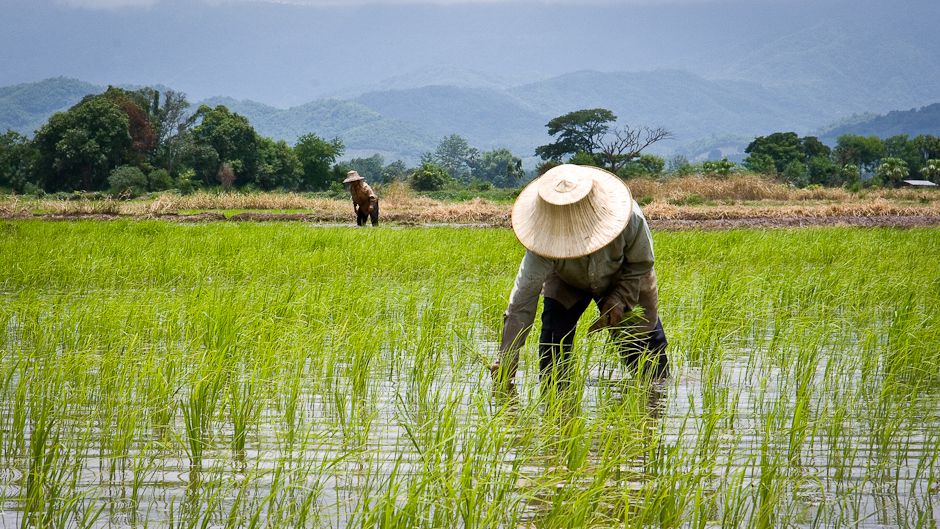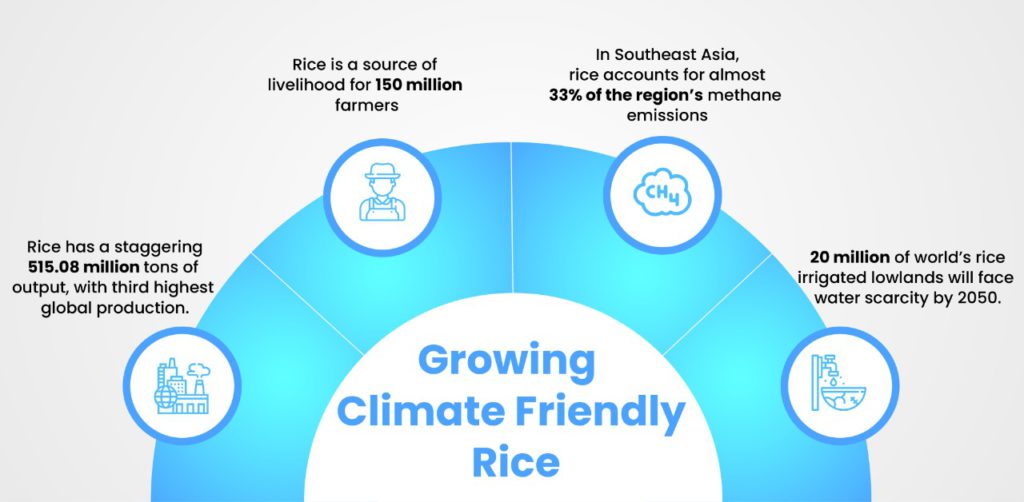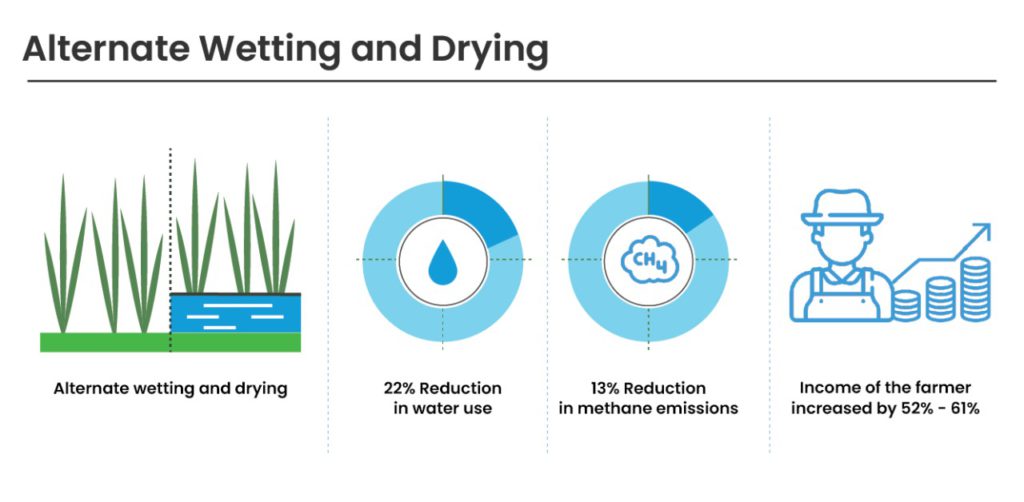Contact: +91 99725 24322 |
Menu
Menu
Quick summary: Cultivating a greener future through sustainable rice farming. Explore innovative practices, resource conservation, and eco-conscious methods in our comprehensive guide to sustainable rice cultivation.

Rice serves as the primary dietary staple for a staggering 3.5 billion individuals worldwide and plays a pivotal role in the livelihoods of over 1 billion people. However, this essential crop has a dark side – it ranks among the most environmentally detrimental crops globally, emitting greenhouse gases equivalent to the entire aviation industry, which necessitates sustainable rice cultivation. Furthermore, each year, millions of tons of rice straw are incinerated in paddy fields, resulting in severe local air pollution that adversely impacts the health of millions.
According to the Sustainable Rice Platform (SRP), rice uses between 30% and 40% of the world’s irrigation water for production,
More than 60 % of the population in India is engaged in rice growing with more than 80% of them being smallholders. Climate change in the rice value chain will bring serious implications for the livelihood of these farmers and cause food insecurity.
1More than one-fifth of all calories consumed worldwide come from rice, the most popular cereal grain with the third-highest global production. Although Asia and some regions of Africa are good places to grow rice, it can be grown anywhere with good planning and irrigation.

Seeds are sown in prepared beds, and after 25 to 50 days, the seedlings are transplanted into fields that are surrounded by a pier that is submerged in water. Quality yield depends mainly on irrigation, the quality of seed and the quality of the soil. Rice is produced on clay, silt, or muck depending on the region and the type of climate.
Rice harvesting is a complex procedure that is done both manually and mechanically. It needs many threshing processes, which are then dried out to reduce the moisture content. The rice that has been harvested is called paddy and is now referred to as brown rice since it is covered by a hull, chaff, or husk. Additionally, milling will result in white rice grains. To give this white rice a glossy look, additional coatings with talc or glucose can be added. Many of the nutrients in brown rice are lost during this milling process which turns it into white rice.
While most of the rice that is produced around the world is used for human consumption, products of milled rice, like the bran and the rice starch are both used in brewing, distilling, fuels, fertilizer, producing oil and for livestock.
The rice supply chain functions as a traditional multi-stage supply system. Its basic framework would include farmers as the basic suppliers of paddy, middlemen, processing industries, distributors and retailers.
Conventional rice farming often relies on continuous flooding of paddy fields, which leads to excessive water usage. Rice is a water-intensive crop, and this practice can strain water resources, especially in water-scarce regions.
The excessive use of water can result in the contamination of water bodies due to the leaching of fertilizers and pesticides. This contaminates local water sources, affecting not only the environment but also the health of nearby communities.
Continuous flooding of fields can lead to soil degradation and salinity issues, particularly in low-lying areas. Over time, the soil becomes less fertile and less suitable for rice cultivation.
Soil erosion is also a concern in conventional rice farming, especially in regions with heavy rainfall. Erosion can lead to loss of topsoil and further reduce the productivity of farmland.
Methane (CH4) emissions from flooded rice fields are a significant contributor to greenhouse gas emissions. When organic matter decomposes anaerobically in waterlogged conditions, it releases methane, which is a potent greenhouse gas.
Inefficient use of fertilizers and energy-intensive practices in conventional rice farming can also contribute to carbon dioxide (CO2) emissions.
Conventional rice farming often involves high production costs, including the expenses associated with flooding and maintaining paddy fields, as well as the cost of chemical inputs like fertilizers and pesticides.
Farmers may also incur costs related to water management, including the construction and maintenance of irrigation systems.
Small-scale rice farmers are particularly vulnerable to the challenges of conventional rice farming. High production costs can limit their ability to invest in modern agricultural practices and technology.
Market volatility and fluctuating rice prices can also pose a risk to small farmers, affecting their income and livelihoods.
Traditional rice cultivation practices, such as transplanting seedlings by hand and manual weeding, can be labour-intensive. This can lead to high labour costs and potential labour shortages during peak farming seasons.
Labor-intensive methods can be physically demanding for farmers and limit their ability to diversify into other crops or income-generating activities.
Efficient water management is a key principle in sustainable rice cultivation. It involves practices like the controlled application of water to paddy fields, as opposed to continuous flooding. Techniques like Alternate Wetting and Drying (AWD) and precise irrigation systems help optimize water use. This approach conserves water resources, reduces the carbon footprint associated with methane emissions from flooded fields, and minimizes the risk of water scarcity in rice-growing regions.
Ready to dive deeper into the world of sustainable agriculture and the critical role water conservation plays?
Explore our comprehensive blog
Soil health and preservation are vital for sustainable rice farming. This includes strategies such as crop rotation, cover cropping, and reduced tillage to maintain soil structure and fertility.
Healthy soils can store more carbon, reduce erosion, and enhance nutrient cycling, ultimately leading to increased rice yields and long-term soil sustainability.
Sustainable rice cultivation promotes reduced chemical inputs, such as synthetic fertilizers and pesticides. Integrated pest management (IPM) practices help minimize the need for chemical treatments.
By reducing the use of harmful chemicals, farmers can protect the environment, enhance the quality of rice, and reduce health risks for both farmers and consumers.
Promoting crop diversity in rice cultivation can help reduce disease and pest pressures. Crop rotation with other non-rice crops and the planting of different rice varieties can enhance biodiversity and provide a broader range of nutrients to farmers and their communities.
Crop diversity also ensures food security by reducing the dependence on a single staple crop.
Sustainable rice farming practices prioritize the use of natural enemies, resistant crop varieties, and beneficial microorganisms to control pests and diseases. This reduces the reliance on chemical pesticides.
Integrated approaches to pest and disease management consider the entire ecosystem, working to maintain a balance between pests and their natural predators.
Integrating trees and agroforestry systems in rice fields enhances biodiversity and ecosystem services. Trees provide shade, support beneficial insects, and improve soil fertility.
Agroforestry also contributes to carbon sequestration, mitigating climate change, and can provide additional income sources through the sale of timber and non-timber forest products.
Sustainable rice farming emphasizes fair trade practices, ensuring that farmers receive equitable compensation for their produce. Fair pricing and access to markets that value sustainability are essential.
Fair trade promotes social well-being and empowers farmers economically, enabling them to reinvest in their farms and communities.
Sustainable rice cultivation engages and supports local communities. This includes providing access to education, healthcare, and infrastructure, as well as promoting women’s involvement in agriculture.
Community support initiatives can help improve living conditions and enhance the overall quality of life for rice farmers and their families.
Sustainable rice farming systems are designed to withstand various challenges, including climate change and market fluctuations. Crop diversification, agroecological practices, and building local knowledge contribute to the resilience of farming systems.
Resilient farming systems ensure food security, livelihoods, and the sustainability of rice cultivation in the long run.
Organic rice farming is a method of cultivating rice without the use of synthetic chemicals such as pesticides and synthetic fertilizers.
Organic rice farming adheres to specific certification and standards to ensure that the crop is grown using environmentally friendly and sustainable practices. These standards are important for maintaining the integrity of organic products and instilling consumer confidence.
Farmers seeking organic certification must undergo a transition period during which they adhere to organic practices without using synthetic chemicals. The certification process includes documentation, on-site inspections, and adherence to the defined standards. Once certified, farmers can label their rice as “organic,” gaining access to premium markets that value sustainable and environmentally friendly agriculture. The certification and adherence to these standards provide transparency and credibility to organic rice products, benefitting both consumers and environmentally conscious farmers.
This is an innovative and sustainable method of rice cultivation that focuses on improving yields while using fewer resources. System of Rice Intensification has gained popularity as a sustainable and productive method for rice cultivation, with the potential to address food security, resource conservation, and climate change adaptation in rice-growing regions around the world.
Benefits
Curious to see how a major exporter harnessed the power of TraceX’s traceability solutions to revolutionize their Basmati rice production?
Dive into our case study to discover how this exporter achieved sustainability goals, enhanced quality, and gained a competitive edge in the market – Know more
Alternate Wetting and Drying is a water-saving and environmentally friendly practice that not only benefits rice farmers but also promotes the overall sustainability of rice cultivation by conserving water resources, reducing greenhouse gas emissions, and enhancing soil and economic health.
It involves periodically allowing the paddy fields to dry out partially or completely rather than maintaining continuous flooding.

Learn how VNV advisory connects with TraceX for driving sustainability practices
Direct Seeded Rice (DSR) Practice is an innovative method of rice cultivation where rice seeds are sown directly into the field without the need for transplanting young seedlings. Direct Seeded Rice (DSR) practice is gaining popularity as an efficient and sustainable method for rice cultivation, offering multiple resource-saving benefits that contribute to both economic and environmental sustainability.
Agroecological Approaches are sustainable farming practices that focus on working with natural ecosystems and processes to promote agricultural productivity while minimizing the negative environmental and social impacts of conventional agriculture.
These include:
These agroecological approaches promote sustainable and resilient farming systems. They reduce the reliance on synthetic inputs, conserve natural resources, and enhance the overall health and productivity of agricultural ecosystems, making them essential for the long-term sustainability of agriculture.
Technological Innovations in Sustainable Rice Cultivation play a crucial role in enhancing productivity, resource efficiency, and environmental sustainability.
Water Management: Climate-smart practices incorporate efficient irrigation techniques like Alternate Wetting and Drying (AWD) and System of Rice Intensification (SRI) to conserve water and reduce methane emissions.
Resilient Crop Varieties: Climate-smart agriculture emphasizes the use of crop varieties bred for resilience to changing weather patterns, including increased temperatures and altered rainfall.
Agroforestry: Integrating trees into rice fields provides shade, enhances carbon sequestration, and supports biodiversity, making rice farming more resilient to climate change.
Conservation Tillage: Reducing soil disturbance through conservation tillage helps prevent erosion and maintain soil health, which is essential for climate adaptation.
Carbon Sequestration: Practices like cover cropping and agroforestry promote carbon sequestration in the soil and vegetation, reducing the carbon footprint of rice cultivation.
These technological innovations and climate-smart practices are critical for making rice cultivation more sustainable and resilient in the face of environmental challenges while increasing productivity and reducing resource use.
TraceX’s DMRV solutions provide a comprehensive, technology-driven approach to tracking, quantifying, verifying, and reporting on sustainable practices in agriculture. By doing so, they play a critical role in the generation of high-quality carbon credits, which are vital for climate action and sustainability goals.
In conclusion, sustainable rice cultivation is not just a farming method; it’s a commitment to a healthier planet and a more prosperous future. By embracing practices like efficient water management, biodiversity preservation, and responsible soil health maintenance, we can reduce the environmental impact of rice farming, increase yields, and improve the well-being of farmers and their communities. The adoption of innovative technologies and a shift in mindset toward eco-conscious agriculture are paving the way for a more sustainable and resilient rice industry. As we face the challenges of climate change, resource scarcity, and food security, sustainable rice cultivation offers a path forward, one that allows us to nourish our growing global population while protecting our precious natural resources and ensuring a greener, more sustainable future.
